


|
|
|
|||||||||||||||
|
|
||||||||||||||||
|
|
||||
|
|
Italy Venice Saint Mark's Basilica
Located at the eastern side of the Piazza San Marco (St Mark’s Square) the Basilica was originally the chapel of the Doge and is connected to the Doges Palace. It became the city’s cathedral in 1807 when it became the seat of the Patriarch of Venice.
The first St Mark’s building was constructed in 828-832 to house the relics of Saint Mark obtained by Venetian merchants from Alexandria in 828. In 976 the chapel was destroyed during a rebellion when the Doge Pietro IV Candiano was locked inside his palace which was then set on fire, the fire spreading to the chapel. It was rebuilt in 978 although nothing is known of the architectural design of these buildings. The current Basilica with its Byzantine and Gothic architecture is believed to date from 1080-90s with completion and consecration occurring at the beginning of the 12th century. During the work in 1094, a body believed to be that of Saint Mark was discovered in a pillar. In 1106 the building was damaged by a fire which especially affected the mosaics, and it is not known if any of the current mosaics in the body of the basilica predate this fire, although some of the mosaics in the porch are known to date prior to the fire. The first half of the 13th century saw the construction of the narthex, a new façade, and the covering of the domes with new timber and lead-covered construction in order to blend with the new aspects of the Doge’s Palace and its Gothic architecture. The building has not altered much since that time although its decorations have, although they retained their majestic golden appearance. The exterior brickwork was covered with marble cladding and additional carvings were brought from other buildings. It was during the 13th century that its function changed from a private chapel of the Doge to that of being the State Church. It became the place for public ceremonies such as the installation and burial of the Doge and housed the throne of the Doge and the local Bishop. The façade overlooking St Mark’s square consists at the lower level of five round-arched portals with marble columns, these lead into the narthex through large bronze doors. 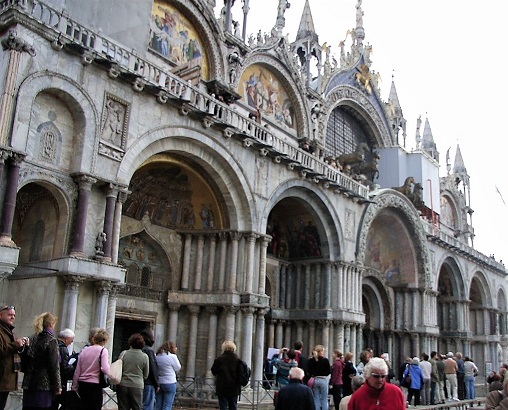 Above these are a number of ogee arches depicting scenes from the life of Christ and the last judgment. Most of the mosaics having been replaced over the years. 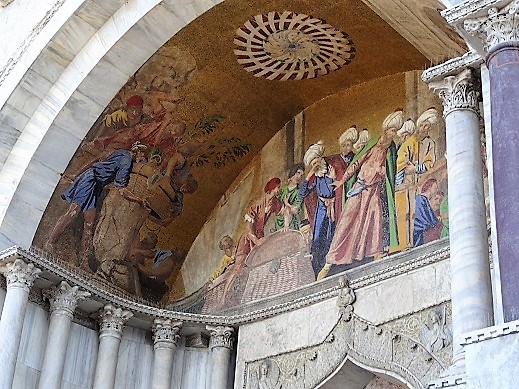 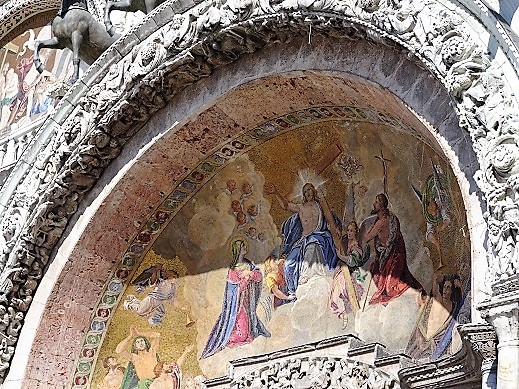 Along the roofline is a line of statues, many in their own small pavilions. In the centre is Saint Mark flanked by six angels, located above a large gilded winged lion the symbol of St Mark and of Venice. 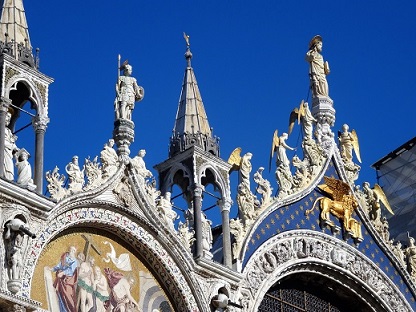 In the upper part of the façade above the ogee arches are statues of Theological and Cardinal Virtues, four Warrior Saints, Constantine, Demetrius, George, Theodosius, and St Mark. Situated on the balcony above the portal are the Horses of Saint Mark. 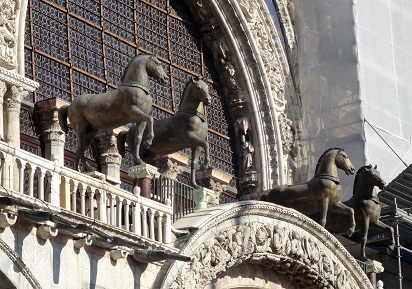 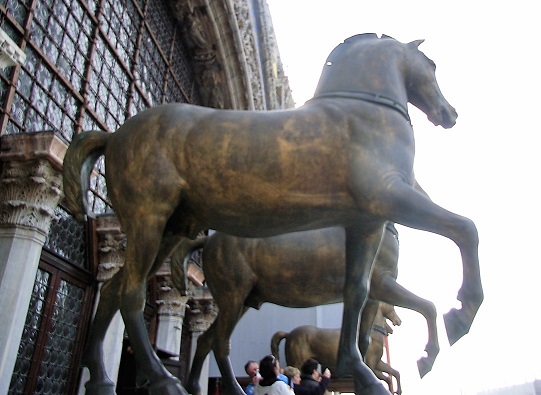 These are now bronze replicas with the originals being displayed inside the Basilica. 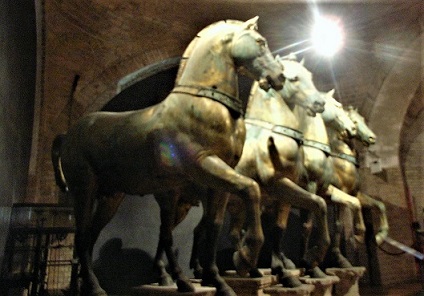 These, it is believed, were originally on the Arch of Trajan but were for many years at the Hippodrome of Constantinople until 1204 when they were looted by the Venetians during the Fourth Crusade. In 1797 they were taken to Paris by Napoleon but were returned to Venice in 1815.
In the south-west corner is the statue of the Four Tetrarchs, this relates to the government of the Roman Empire during the third century which had four people co-ruling the empire. This too was brought from Constantinople during the Fourth Crusade, part of the foot of one of the Tetrarchs is missing; this was found in Istanbul (previously called Constantinople) in the 1960s and is on display there to show the original location. The narthex or porch is believed to have been built on the western side of the basilica in the 13th century. The following century part was taken to produce the Baptistery. The ceiling contains mosaics depicting stories from the Old Testament which include Genesis and the life of Noah, Abraham, and Moses. Also in the narthex, by the main door are statues of the Four Evangelists. It also contains the 11th-century mosaics that decorated the old façade of St Marks before the narthex was constructed. 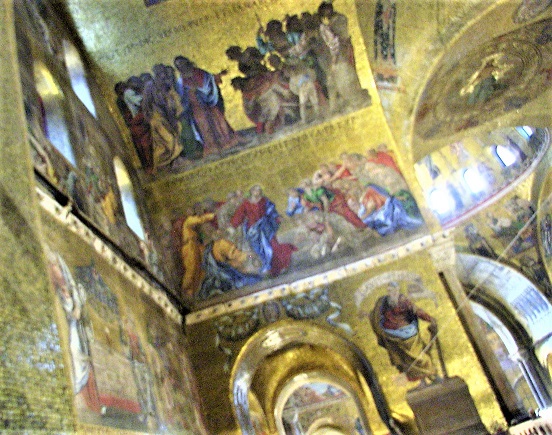 After the fire of 1419, there was a problem in obtaining a suitably skilled person to organise the restoration work and they had to seek help from Florence. Initially, the work was carried out in the style to replicate the existing architecture but this was later changed for something of a more contemporary nature. The internal decorations consist of numerous mosaics, depicting scenes related to Christ and his life and the saints, unfortunately, photography is not permitted in the interior but the author was able to take some in the narthex which will give an indication of what it looks like. The Basilica also contains a shop and photography is allowed there. 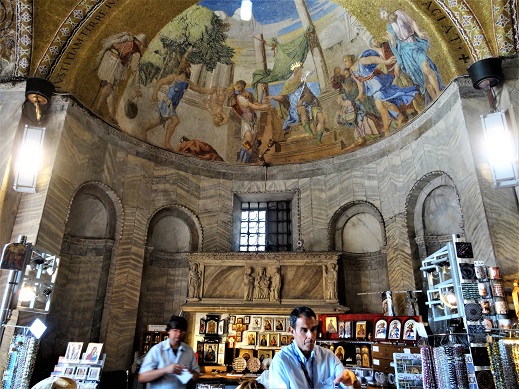 To the eastern side of the interior is a raised presbytery (chancel) separated by an altar screen formed by eight red marble columns topped with statues and a crucifix. Behind this screen is a marble banister with bronze statues of the Evangelists. It is the altar that contains the relics of St Mark, below which is the crypt. The altarpiece is the Pala d’Oro which consists of two parts and contains 1,300 pearls, 300 sapphires, 300 emeralds, and 400 garnets. This is believed to have originated in 1102 but adopted its current form in 1343 when the two parts were joined. Above the altar on columns is a canopy. Behind the presbytery is the sacristy and a 15th-century church dedicated to Saint Theodore, the first patron saint of Venice. The treasury contains a collection of metalwork, enamel, and stone carvings, most of which are Byzantine and were looted from Constantinople during the Fourth Crusade. To see more photographs and take a virtual tour of the site click on the photoshow below.
|
|
||
|
|
||||
All Photographs were taken by and are copyright of Ron Gatepain
| Site Map |
